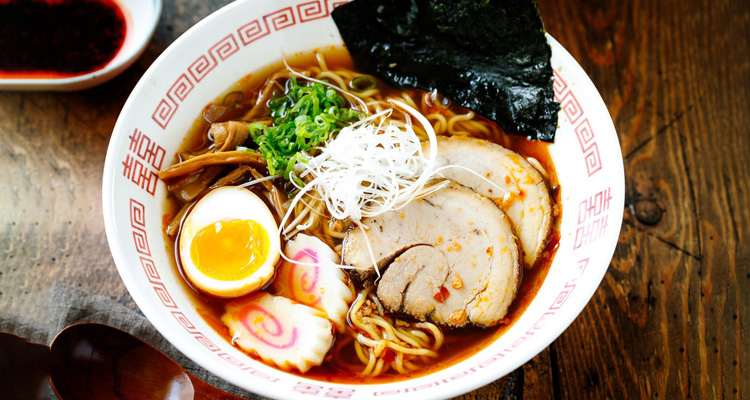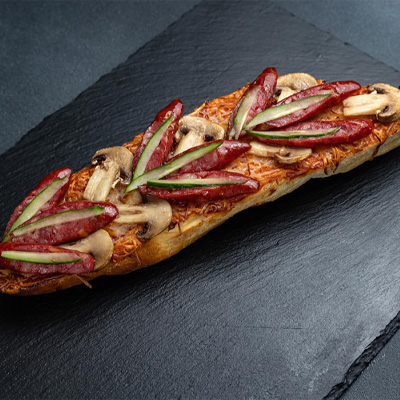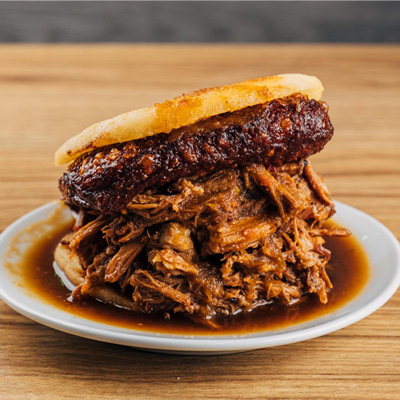Ramen, a beloved and iconic dish, has transcended its humble origins to become a global comfort food sensation. This steaming bowl of flavorful broth, tender noodles, and an array of toppings has captured the hearts and taste buds of people worldwide. In this article, we'll explore the history, the art of crafting the perfect ramen bowl, and the diverse world of ramen styles and flavors.
Nutrition Facts
- Kcal
450 - Fat
12 g - Choles
160 mg - Sodium
1100 mg - Carbs
54 g - Fiber
2 g - Sugar
3 g - Protein
29 g
Note: The nutrition facts are approximate values and may vary based on the specific ingredients used and any additional toppings or syrups added.
Ingredients
For the Broth
- 4 cups chicken broth
- 4 cups water
- 2 cloves garlic, minced
- 1 piece of ginger (about 2 inches), sliced
- 2 tablespoons soy sauce
- 1 tablespoon sesame oil
- 1 tablespoon miso paste (optional, for added depth of flavor)
- Salt and pepper to taste
For the Noodles and Toppings
- 8 ounces ramen noodles (fresh or dried)
- 1/2 pound thinly sliced pork (pork belly, loin, or shoulder)
- 2 soft-boiled eggs
- 2 sheets of nori (seaweed), cut into thin strips
- Sliced green onions
- Bamboo shoots (canned or fresh, thinly sliced)
- Corn kernels (optional)
Directions
For the Broth
- In a large pot, combine the chicken broth, water, minced garlic, sliced ginger, soy sauce, sesame oil, and miso paste (if using). Bring to a boil.
- Reduce the heat to low and simmer the broth for about 20-30 minutes to allow the flavors to meld. Season with salt and pepper to taste.
For the Pork
- In a separate skillet, cook the thinly sliced pork over medium-high heat until it's cooked through and slightly caramelized. This should take about 2-3 minutes per side. Remove from heat and set aside.
For the Eggs
- Soft-boil the eggs by placing them in a pot of boiling water for about 7 minutes. Then, transfer them to an ice water bath to cool. Once cooled, peel and cut them in half.
For the Noodles
- Cook the ramen noodles according to the package instructions. Drain and set aside.
To Assemble the Ramen
- Divide the cooked ramen noodles among serving bowls.
- Ladle the hot broth over the noodles.
- Arrange the sliced pork, soft-boiled eggs, nori strips, sliced green onions, bamboo shoots, and corn kernels (if using) on top of the noodles.
A Journey Through Time
Ramen's roots can be traced back to China, where it originated as a wheat noodle dish. It was brought to Japan by Chinese immigrants in the late 19th century. Over time, ramen evolved into a uniquely Japanese culinary treasure, with regional variations and a dedicated following.
The dish gained immense popularity in Japan in the mid-20th century, especially after World War II when it became an affordable and accessible meal for many. Since then, ramen shops, or "ramen-ya," have proliferated, each offering its take on this comforting soup.
The Art of Crafting Ramen
Creating the perfect bowl of ramen is both an art and a science. While there are countless variations, the basic components of a classic ramen bowl include:
-
Broth:
- Tonkotsu: A rich, creamy broth made from simmering pork bones.
- Shoyu: A clear soy sauce-based broth with a delicate flavor.
- Miso: A hearty broth made with fermented soybean paste, offering a robust umami taste.
- Shio: A simple, salt-based broth that allows other ingredients to shine.
-
Noodles:
- Ramen noodles come in various thicknesses and shapes. The choice of noodles can significantly impact the dish's overall texture.
-
Toppings:
- Chashu: Slices of tender, braised pork belly.
- Ajitama: Soft-boiled and marinated eggs with a custard-like yolk.
- Menma: Fermented bamboo shoots.
- Nori: Sheets of dried seaweed.
- Scallions: Fresh green onions.
- Corn, bean sprouts, and other vegetables are often added for extra flavor and texture.
-
Aromatics:
- Garlic, ginger, and sesame oil are common flavor enhancers.
Ramen Styles Around the World
While ramen has its origins in Japan, it has evolved and adapted in various countries. Here are some notable international ramen styles:
- Tsukemen (Dipping Ramen) - Japan
In this style, the noodles are served separately from the broth, which is thicker and more concentrated. Diners dip the noodles into the broth, savoring each bite.
- Jjapaguri - South Korea
This Korean fusion dish combines ramen noodles with a black bean sauce. It's known for its savory, umami-rich flavor.
- Pho - Vietnam
While not traditional ramen, Vietnamese pho shares similarities, featuring rice noodles and a flavorful broth. It showcases the fusion of culinary traditions.
- Ramyeon - South Korea
Ramyeon is the Korean version of instant ramen, often customized with various toppings, such as vegetables, eggs, and even cheese.
Ramen FAQs
What's the difference between ramen and instant ramen?
Instant ramen is a convenient, pre-packaged version of ramen that typically includes dehydrated noodles and a powdered soup base. Traditional ramen is made from scratch with fresh ingredients.
Can I make vegetarian or vegan ramen?
Absolutely! There are many delicious vegetarian and vegan ramen recipes that use vegetable broth and plant-based protein options.
Are there regional variations of ramen in Japan?
Yes, there are countless regional styles of ramen in Japan, each with its unique broth, noodles, and toppings. Some famous regional styles include Sapporo, Hakata, and Hokkaido.
How should I eat ramen?
There's no one right way to eat ramen, but it's common to use chopsticks for noodles and a spoon for the broth. Feel free to slurp your noodles; it's a sign of enjoyment in many Asian cultures.
Can I customize my ramen toppings?
Absolutely! Ramen is highly customizable. You can add or omit toppings based on your preferences. It's all about creating your perfect bowl.
Conclusion
Ramen is more than just a meal; it's a bowl of warmth, comfort, and cultural history. Whether you're savoring a classic bowl of tonkotsu ramen in Tokyo or experimenting with international ramen styles at home, each slurp is an invitation to explore the diverse world of flavors, textures, and traditions that make ramen a timeless and cherished culinary treasure. So, the next time you enjoy a steaming bowl of ramen, take a moment to appreciate the rich heritage and delightful complexity that this beloved dish brings to your table.













